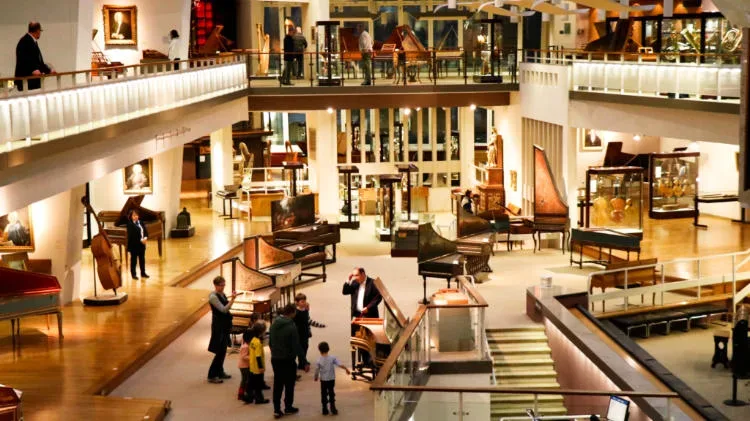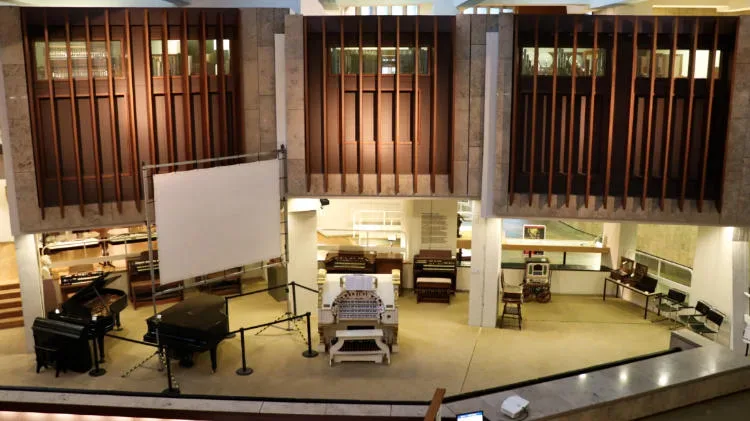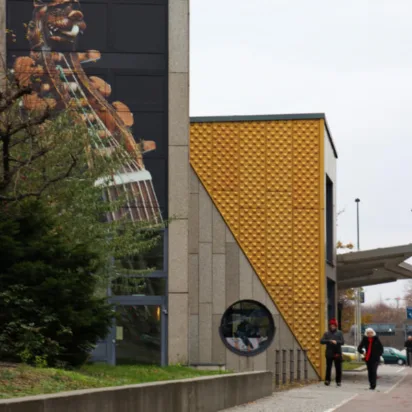The Musikinstrumenten-Museum in Berlin has 800 historic musical instruments on display. Try visiting when the Mighty Wurlitzer theater organ is played.
The remarkable collection of Musical Instruments Museum (Musikinstrumenten-Museum) in Berlin includes around 3,500 European musical instruments from the last five centuries. Many of the displays are as much works of art, as they are musical instruments. Many may be heard in action on the free audio guide, while some are also played during guided tours. The museum has many unique pieces, instruments that belonged to royalty and composers, as well as the largest playable theater organ in Europe.
Musical Instruments Museum in Berlin
The Musikinstrumenten-Museum in Berlin is one of the largest and most important collections of historical instruments in the world. Despite major losses during the Second World War, the collection includes around 3,500 instruments of which more than 800 are on permanent display.
The instruments are mostly European instruments from the 16th century to the present. In addition to the highlights and curiosities, the museum is particularly interested in keyboard instruments such as harpsichords, clavichords, and organs, string instruments, wind instruments, automatic instruments, electronic instruments, instruments from the Wiener Klassik and instruments produced in Berlin.
Most of the instruments are on display on the main floor in a large open-plan floor space. Further instruments are on an upper gallery where the inside of the Wurlitzer organ chambers may be seen in action. In the basement are a few further instruments and a small café.
The Mighty Wurlitzer Theater Organ in Berlin
The largest and noisiest exhibit in the museum is the Mighty Wurlitzer – one of the largest theater organs in Europe. It was originally installed in 1929 in the private theater of Werner Ferdinand von Siemens, grandson of the Siemens company founder, but it was confiscated during the war and eventually found its way into the museum.
The white, horseshoe-shaped console is on the ground floor of the museum while the instruments are in three rooms on the higher level – windows allow visitors to look into the main chamber, orchestra room, and solo rooms to see the instrument at work. Further mechanical and electrical parts such as the wind machine, bellows, and relay stations are hidden in the basement.
This Wurlitzer has four manuals, 16 ranks, 1228 pipes, 19 effects, and 175 stop buttons. A complex multiplex system allows some manuals to play up to 97 pipes despite each having only 61 keys.
The best thing about the Mighty Wurlitzer theater organ in the Musical Instruments Museum is that it is playable and often played with gusto. The main event is Saturdays at noon when it is demonstrated in a short organ concert but it is also played at the end of other guided tours so it may often be heard in action on weekday mornings when small school groups tour the museum.
Once a month during winter, the Wurlitzer organ may be heard as was originally intended: as an accompaniment to a silent movie. (These organs could replace an orchestra of up to 70!) These Mittwochskino is on Wednesday evenings at 18:00. Admission is €6 and advance reservations (often not essential) are possible at the museum.
Highlights in the Musical Instruments Museum in Berlin
Among the highlights of the Musikinstrumenten-Museum in Berlin are a variety of harpsichords (cembali). The most famous is the so-called Bach-Cembalo – on the upper floor together with copies used to reproduce the sound. It came from the Bach family although it is not possible to prove that Johann Sebastian actually played it himself.
Some of the most valuable and oldest keyboard instruments in the museum are four harpsichords produced by the Ruckers family in Antwerpen in the early 17th century.
A further traveling harpsichord (Reisecimbalo) belonged to Queen Sophie Charlotte and was used in the court of Frederick the Great. This harpsichord could be folded into three pieces for easier transportation.
The museum also has a large variety of interesting wind instruments. Historically the most interesting is probably the collection of early Baroque wind instruments used by the Naumburg town piper ensemble. The museum also has several flutes that belonged to Frederick the Great.
Several further unique pieces are on display including many of very unusual shapes despite being instruments as familiar as the fagot or clarinet. Others are just delightfully oddly shaped.
The museum also has a small collection of early electronic musical instruments including a Trautonium (first produced in the late 1920s), a multimonica from the 1940s, and early synthesizers.
Musical Instruments Museum Berlin Visitors Information
Opening Hours of the Musikinstrumenten-Museum
From mid-April 2024, the opening hours of the Musical Instruments Museum in Berlin are varied. It is open on:
- Tuesday: 9:00 to 13:00
- Wednesday and Friday: 9:00 to 17:00
- Thursday: 09:00 to 20:00
- Saturday and Sunday: 10:00 to 17:00
During the summer vacations (23 July to 30 August 2024), the museum is open from 13:00 only on weekdays, and normal hours on weekends.
The museum opens an hour earlier than the others in Kulturforum making it a good choice for early risers.
The best time to visit the museum is when the Wurlitzer organ is demonstrated – at noon on Saturdays or at the end of guided tours.
Musical instruments are also demonstrated during guided tours – good value at only €3 – which are mostly Thursday at 18:00 and Saturday at 11:00. Visitors not part of the tour will still be able to hear the instruments at play, which makes weekday morning also a good choice when small kindergarten and school groups are guided through the museum.
Tickets for the Musical Instruments Museum in Berlin
Admission to the Musikinstrumenten-Museum in Berlin is €10 for adults and free for visitors under 18.
Ask for the audio guide – currently free – which has recordings of many of the still playable instruments. (For visitors, it is very much no-touching of any instruments although a few models may be handled to test sounds and explore techniques.)
The Musical Instruments Museum is also included in the Kulturforum Ticket of the national museums and admission is free with the excellent value Berlin Museum Pass – 30 museums in three days for €32.
Admission is usually free on the first Sunday of each month.
Concerts in the Musical Instruments Museum in Berlin
The concert hall inside the Musikinstrumenten-Museum is also occasionally used for concerts. Regular concert series include the Alte Musik Live, during which mostly 17th to 19th-century music is played on historical instruments, Jour Fixe where younger artists perform, and Jazz in MiM.
Tickets are available at the museum ticket counter.
Transportation to the Musical Instruments Museum
The Musikinstrumenten-Museum in Berlin, entrance in Ben-Gurion-Straße, is behind the Berliner Philharmonie across the road from the rear entrance to the Sony Center and thus only a long block from Potsdamer Platz.
The closest bus stops are Philharmonie on the very convenient bus 200 and 300, or use buses M48 and M85 (stop Kulturforum / Varian-Fry-Straße). All the public transportation options at Potsdamer Platz are only a block away.
A visit to the Musikinstrumenten-Museum combines well with a visit to the Berliner Philharmonie – daily guided tours and free lunchtime concerts on Tuesdays – and all the other museums in Kulturforum including the Gemäldegalerie, Neue Nationalgalerie, and the Applied Arts Museum.
More on the Berlin State Museums (Staatliche Museen zu Berlin):
Note new opening times for many Berlin museums from mid-April 2024. Timeslot reservations are essential only for the Caspar David Friedrich exhibition (until 4 August 2024) but sensible (and sometimes needed in busy periods!) for the Alte Nationalgalerie, Gemäldegalerie, Neue Nationalgalerie, Neues Museum, and Pergamon – Das Panorama. (The Pergamon Museum itself is closed until 2027!). Timeslots are released only a few weeks in advance. Online tickets are available from GetYourGuide, which seems to have timeslots available when SMB has already sold out. Many passes and multi-museum tickets are again sold (Kulturforum / Museums Island). Individual museum ticket prices range from €8 to €14 (€20 for special exhibitions). Online tickets are skip-the-line — go directly to the gallery entrance to scan the code but pick up free audioguides first.
For more general information on the Berlin State Museums:
- Top National Museums and Galleries in Berlin (brief overview)
- Berlin State Museums: What Is Seen Where? (a short description of the collections in the different museums)
- Opening Hours of Berlin State Museums (2024) — major changes from mid-April 2024!
- Ticket Prices for Berlin State Museums (prices for museums, temporary exhibitions, combination tickets, online time-slot reservations). Buying online from GetYourGuide is easy. A ticket with a QR or bar code is scanned directly at the entrance — no need to pass by the ticket desk (but pick up the free audio guide before entering).
- Save with the Berlin Museum Pass – 30 museums (including all the SMB museums) in three days for €32 – a fantastic savings deal.
- Staatliche Museen zu Berlin (official website in German & English).
News & Temporary Exhibitions:
- 2024: Overview of Top Berlin Exhibitions in 2024, Caspar David Friedrich in the Alte Nationalgalerie (tickets are selling out fast!), Frans Hals in the Gemäldegalerie, Neue Nationalgalerie (20th-century art) Hamburger Bahnhof Contemporary Art, Kupferstichkabinett (Prints and Drawings), and Photography Museum.
- Museums closed in 2024: The Pergamon Museum is closed until 2027 (some sculptures are on display in Das Panorama), the Museum Berggruen is closed until 2025 (much of its collection is traveling the world), the permanent collection of the German History Museum (Zeughaus) is closed but temporary exhibitions continue in the Pei Building.
More Museum Reviews and Museum-Specific Information:
- Alte Nationalgalerie with Caspar David Friedrich paintings (2024 special exhibition).
- Altes Museum with Greek, Etruscan, and Roman art.
- Ethnological and Asian Art Museums in the Humboldtforum.
- Friedrichswerdersche Kirche (free admission) with a collection of 19th-century German sculptures.
- Gemäldegalerie with its collection of German and Dutch Old Masters and Italian paintings.
- Kunstgewerbemuseum (Decorative Arts).
- Musical Instruments Museum near the Berliner Philharmonie.
- Neue Nationalgalerie — 20th-century art.
- Neues Museum with bust of Nefertiti.
- Pergamon Museum with Ishtar Gate — the whole Pergamonmuseum is closed from October 2023 until 2027. Some Greek sculptures are shown in the
- Pergamon Museum Panorama Exhibition with Asisi panoramic painting and Greek statues.
- Photography — Helmut Newton collection and historic photos.
Previous Temporary Exhibitions:
- 2023: Top Special Temporary Exhibitions in 2023 — overview, in the Kulturforum, in the Neue Nationalgalerie, on Museum Island, and the Museum of Photography.
- 2022: Top Special Temporary Exhibitions in 2022 — overview, in the Kulturforum (David Hockney), in the Neue Nationalgalerie, on Museumsinsel, Hamburger Bahnhof contemporary art, and the Museum of Photography.
- 2021: Top Special Temporary Exhibitions in 2021 — including the reopening of the Neue Nationalgalerie, as well as the Ethnological and Asian Art Museums in the Humboldt Forum.
- 2020: Highlights, in Kulturforum, on Museum Island, in the Hamburger Bahnhof, smaller museums, and the opening of the Humboldt Forum.














